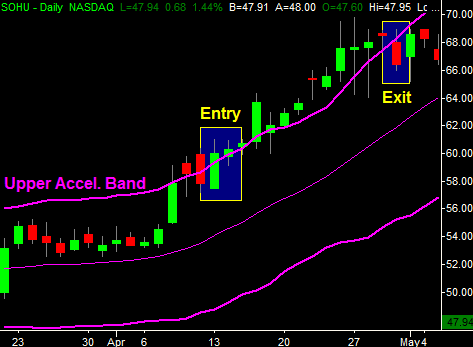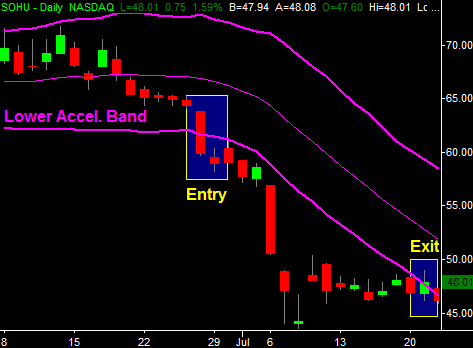Inside BigTrends Acceleration Bands Indicator
Acceleration Bands
BigTrends' Acceleration Bands envelop a stock or index chart, plotting a boundary line above and below it with the finding points in time where a breakout or breakdown has trade-worthy momentum. They’re akin to Bollinger Bands and moving average envelopes, but in many regards are superior to both. Acceleration Bands are more adaptive than moving average enveloped but less volatile than Bollinger Bands… a happy medium, of sorts.
Acceleration Bands are plotted around a simple moving average, which becomes the midpoint between the two bands; the upper and lower bands are of equal distance from this midpoint. The formula used to plot the bands are:
Upper band = ( High * ( 1 + 2 * (((( High - Low )/(( High + Low ) / 2 )) * 1000 ) * 0.001 )))
Lower band = ( Low * ( 1 - 2 * (((( High - Low )/(( High + Low ) / 2 )) * 1000 ) * 0.001)))
The interpretation of Acceleration Band signals is simple enough -- a thrusting move above the upper band or below the lower band suggests a stock or index has begun a move that isn’t just part of its normal volatility. Broadly speaking, Headley prefers to see two consecutive (and progressive) closes on the outside of either Acceleration Band, though that rule of thumb can be tweaked to suit various trading strategies and timeframes.
In the sample chart below, the Acceleration Band buy signal for Sohu (SOHU) comes in the form of the second consecutive and higher close above the upper 20-day band line. It is indeed the beginning of a multi-day eight point advance.
The same strategy can work just as well for bearish, short, or put option trades, however. In fact, only a few days after Sohu served up a buy signal based on Acceleration Bands, it accurately marked a sell/bearish signal.
In both examples, the exit was presumed to be the first close back inside the envelope created by the Acceleration Bands. An entry based on an Acceleration Band cue, however, doesn’t necessarily have to be closed out based on a reversal of its entry rules.
Also note that the length of the Acceleration band can and should be adjusted from its typical setting of 20 bars to better accommodate differing trading styles and timeframes.


